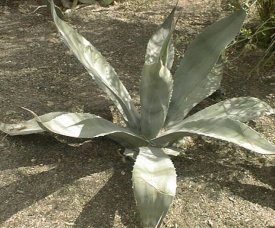Fusang
Today, we discover America -- a thousand years before Columbus. The University of Houston's College of Engineering presents this series about the machines that make our civilization run, and the people whose ingenuity created them.
The Chinese were very isolationist, 1500 years ago. China thought the outside world was benighted and uninteresting -- to be avoided and sealed off, not sought out. But a newer breed of Chinese Buddhists had a different view. Their business was to go out and convert all lands to Buddhism.
In AD 499, a Buddhist missionary, Hoei-Shin, came back from a long voyage and told of a strange people in a strange land -- 20,000 Chinese miles to the east. That would've put him right on the west coast of Mexico.
Hoei-Shin named the place Fusang, after a succulent plant he'd found in that arid land. The natives ate its roots and made wine from its sap. From its thick leaves they made cloth, rope, roof-thatch, and even paper. Hoei-Shin wrote about their society and folkways -- all very unlike anything Chinese.
 Of course, the fusang plant sounds just like the Mexican maguey plant -- the Agave americana which served so many functions for the pre-Columbian natives of Mexico. And we have to ask: Is this another mystery of flying saucers or Bigfoot? Or can we take Hoei-Shin's journey as established historical fact?
Of course, the fusang plant sounds just like the Mexican maguey plant -- the Agave americana which served so many functions for the pre-Columbian natives of Mexico. And we have to ask: Is this another mystery of flying saucers or Bigfoot? Or can we take Hoei-Shin's journey as established historical fact?
A French scholar, Deguignes, wrote about Fusang in 1761. He had limited material, and his work kicked up a firestorm of controversy. A German professor, Neumann, published Hoei-Shin's narrative in 1841 along with a commentary. An American, Charles Leland, translated and expanded Neumann's work in 1875.
It was a long process of raising and resolving questions. Take the route: At first it seemed out of the question to cross the Pacific in a 5th-century Chinese junk. Then we see that circulating currents can take you from China, up the east coast of Japan, past Korea, along the Aleutians, south of Alaska, down the west coast of America to Mexico. The same currents carry you back to China on a westward path, just above the equator.
The very simplicity of that enormous journey is the most convincing argument of all. Since Leland's book, experts have thrashed out the details with little public notice. Anthropologists have found Chinese and Japanese influences and artifacts among Native Americans all the way south to Peru. It appears that what Hoei-Shin was able to do, others probably did as well.
None of this reaches the textbooks. And so we forget. We forget there was a Russian capital on our west coast before the Gold Rush. There was a university in Mexico City before Shakespeare. We forget that, just as the Roman empire fell, Chinese missionaries were preaching -- to pre-Aztec Mexicans.
I'm John Lienhard at the University of Houston, where we're interested in the way inventive minds work.
(Theme music)
Leland, C.G., Fusang; or, The Discovery of America by Chinese Buddhist Priests in the Fifth Century. New York: Barnes & Noble, [1973].
I am grateful to Ms. Jean M. O'Brien, Old Monterey Book Company, Monterey, California, for recommending the topic and the Leland source. See also Episode 1008 for more about pre-Columbian claims to the discovery of America.